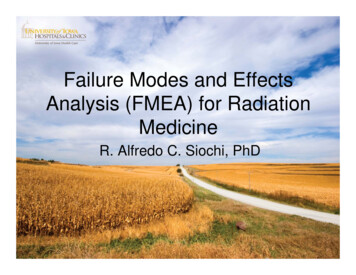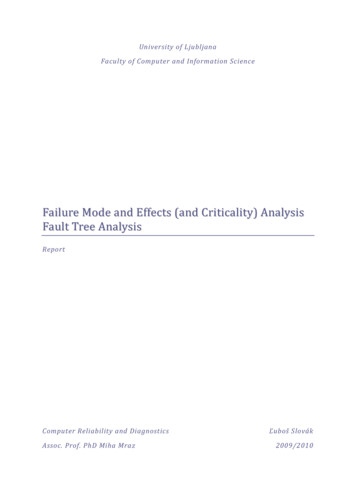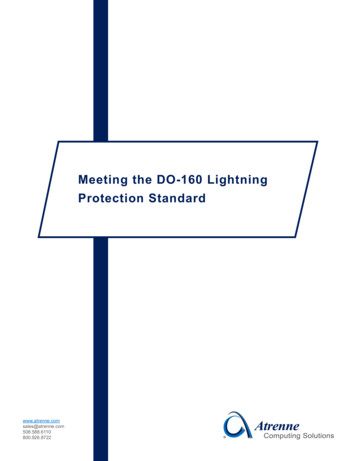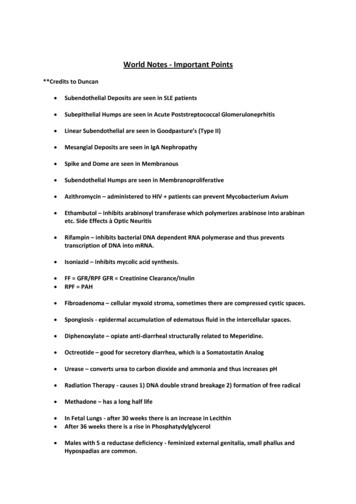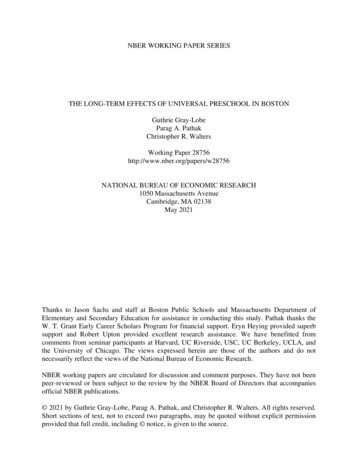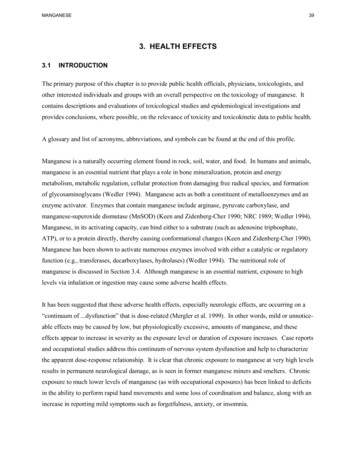
Transcription
MANGANESE393. HEALTH EFFECTS3.1INTRODUCTIONThe primary purpose of this chapter is to provide public health officials, physicians, toxicologists, andother interested individuals and groups with an overall perspective on the toxicology of manganese. Itcontains descriptions and evaluations of toxicological studies and epidemiological investigations andprovides conclusions, where possible, on the relevance of toxicity and toxicokinetic data to public health.A glossary and list of acronyms, abbreviations, and symbols can be found at the end of this profile.Manganese is a naturally occurring element found in rock, soil, water, and food. In humans and animals,manganese is an essential nutrient that plays a role in bone mineralization, protein and energymetabolism, metabolic regulation, cellular protection from damaging free radical species, and formationof glycosaminoglycans (Wedler 1994). Manganese acts as both a constituent of metalloenzymes and anenzyme activator. Enzymes that contain manganese include arginase, pyruvate carboxylase, andmanganese-superoxide dismutase (MnSOD) (Keen and Zidenberg-Cher 1990; NRC 1989; Wedler 1994).Manganese, in its activating capacity, can bind either to a substrate (such as adenosine triphosphate,ATP), or to a protein directly, thereby causing conformational changes (Keen and Zidenberg-Cher 1990).Manganese has been shown to activate numerous enzymes involved with either a catalytic or regulatoryfunction (e.g., transferases, decarboxylases, hydrolases) (Wedler 1994). The nutritional role ofmanganese is discussed in Section 3.4. Although manganese is an essential nutrient, exposure to highlevels via inhalation or ingestion may cause some adverse health effects.It has been suggested that these adverse health effects, especially neurologic effects, are occurring on a“continuum of .dysfunction” that is dose-related (Mergler et al. 1999). In other words, mild or unnoticeable effects may be caused by low, but physiologically excessive, amounts of manganese, and theseeffects appear to increase in severity as the exposure level or duration of exposure increases. Case reportsand occupational studies address this continuum of nervous system dysfunction and help to characterizethe apparent dose-response relationship. It is clear that chronic exposure to manganese at very high levelsresults in permanent neurological damage, as is seen in former manganese miners and smelters. Chronicexposure to much lower levels of manganese (as with occupational exposures) has been linked to deficitsin the ability to perform rapid hand movements and some loss of coordination and balance, along with anincrease in reporting mild symptoms such as forgetfulness, anxiety, or insomnia.
MANGANESE403. HEALTH EFFECTSChemical Forms of Concern. Manganese can exist in both inorganic and organic forms. Thisprofile will discuss key manganese compounds in both forms, with inorganic compounds discussed first.The inorganic forms include manganese chloride (MnCl2), manganese sulfate (MnSO4), manganeseacetate (MnOAc), manganese phosphate (MnPO4), manganese dioxide (MnO2), manganese tetroxide(Mn3O4), and manganese carbonate (MnCO3). Emphasis has been placed on the health effects ofcompounds containing inorganic manganese in the Mn(II), Mn(III), or Mn(IV) oxidation states, sincethese are the forms most often encountered in the environment and the workplace. There is evidence inanimals and humans that adverse neurological effects can result from exposure to different manganesecompounds; much of this information on toxicity differences between species of manganese is fromreports and experiments of acute exposures to very high doses. Results from animal studies indicate thatthe solubility of inorganic manganese compounds can influence the bioavailability of manganese andsubsequent delivery of manganese to critical toxicity targets such as the brain; however, the influence ofmanganese oxidation state on manganese toxicity is not currently well understood. Manganese in theform of permanganate produces toxic effects primarily through its oxidizing capacity. However, becauseof its tendency to oxidize organic material, the permanganate ion is not stable in the environment; thus,the probability of exposure to this species around waste sites is considered very low. For this reason, dataon exposures to permanganate are only briefly discussed.The organic compounds that will be discussed are methylcyclopentadienyl manganese tricarbonyl (MMT)and mangafodipir. The latter is a chelate of Mn(II) and an organic ligand, dipyridoxyl diphosphate(MnDPDP; Mn(II) N,N’-dipyridoxylethylenediamine-N,N’-diacetate 5,5'bis(phosphate)). Thesecompounds were chosen for this profile because their toxicity is expected to be mediated by excessexposure to elemental manganese. Organic fungicides containing manganese, such as maneb, were notchosen for discussion in this profile, because their critical toxic effects are expected to be mediated by theorganic moities of their chemical structure, not by excessive elemental manganese.MMT is a fuel additive developed in the 1950s to increase the octane level of gasoline and thus improvethe antiknock properties of the fuel (Davis 1998; Lynam et al. 1999). Additional information on thechemical, physical, and environmental properties of MMT is included in Chapter 4. Exposure to MMT isexpected to be primarily through inhalation or oral pathways, although occupational exposure for gasolineattendants or mechanics may be more significant via dermal absorption. Engines using MMT-containinggasoline and equipped with catalytic converters primarily emit manganese in inorganic phosphate andsulfate forms and smaller amounts of manganese dioxides can be detected (Mölders et al. 2001; Ressler et
MANGANESE413. HEALTH EFFECTSal. 2000; Zayed et al. 1999a, 1999b). These findings and observations that MMT is very unstable in lightand degrades quickly in air (Garrison et al. 1995) suggest that human exposure to manganese from the useof MMT in gasoline is most likely to occur in inorganic forms as a result of the combustion of MMT,with the exception of people occupationally exposed to uncombusted gasoline containing MMT.However, despite this evidence, there are some reports that MMT levels in the environment increase withtraffic density (Garrison et al. 1995; Zayed et al. 1999a, 1999b); therefore, inhalation and/or ingestionexposures to the parent compound are possible. Exposure and resultant toxicity from MMT’s inorganiccombustion products are covered under the inorganic subsections, while toxicity attributable to MMT iscovered under the organic subsections.Mangafodipir is a contrast agent for magnetic resonance imaging (MRI) used primarily (after intravenousadministration) to detect and characterize neoplastic liver lesions; it has also been found to aid in theidentification of kidney and pancreatic tumors (Federle et al. 2000; Grant et al. 1997a, 1997b; Ni et al.1997). The compound is only used in the diagnosis of organ-specific cancers and is found exclusively ina clinical setting. Mangafodipir is injected intravenously; therefore, inhalation, oral, and dermal pathwaysof exposure are not a concern. Because exposure to this compound is pathway-specific and the exposurepopulation is inherently limited, toxicity arising from exposure to mangafodipir will be discussed in aseparate subsection to Section 3.2.4, Diagnostic Uses.3.2DISCUSSION OF HEALTH EFFECTS BY ROUTE OF EXPOSURETo help public health professionals and others address the needs of persons living or working nearhazardous waste sites, the information in this section is organized first by route of exposure (inhalation,oral, and dermal) and then by health effect (death, systemic, immunological, neurological, reproductive,developmental, genotoxic, and carcinogenic effects). These data are discussed in terms of three exposureperiods: acute (14 days or less), intermediate (15–364 days), and chronic (365 days or more).Levels of significant exposure for each route and duration are presented in tables and illustrated infigures. The points in the figures showing no-observed-adverse-effect levels (NOAELs) or lowestobserved-adverse-effect levels (LOAELs) reflect the actual doses (levels of exposure) used in the studies.LOAELs have been classified into "less serious" or "serious" effects. "Serious" effects are those thatevoke failure in a biological system and can lead to morbidity or mortality (e.g., acute respiratory distressor death). "Less serious" effects are those that are not expected to cause significant dysfunction or death,or those whose significance to the organism is not entirely clear. ATSDR acknowledges that a
MANGANESE423. HEALTH EFFECTSconsiderable amount of judgment may be required in establishing whether an end point should beclassified as a NOAEL, "less serious" LOAEL, or "serious" LOAEL and that, in some cases, there will beinsufficient data to decide whether the effect is indicative of significant dysfunction. However, theAgency has established guidelines and policies that are used to classify these end points. ATSDRbelieves that there is sufficient merit in this approach to warrant an attempt at distinguishing between"less serious" and "serious" effects. The distinction between "less serious" effects and "serious" effects isconsidered to be important because it helps the users of the profiles to identify levels of exposure at whichmajor health effects start to appear. LOAELs or NOAELs should also help in determining whether or notthe effects vary with dose and/or duration and place into perspective the possible significance of theseeffects to human health.The significance of the exposure levels shown in the Levels of Significant Exposure (LSE) tables andfigures may differ depending on the user's perspective. Public health officials and others concerned withappropriate actions to take at hazardous waste sites may want information on levels of exposureassociated with more subtle effects in humans or animals (LOAELs) or exposure levels below which noadverse effects (NOAELs) have been observed. Estimates of levels posing minimal risk to humans(Minimal Risk Levels or MRLs) may be of interest to health professionals and citizens alike.A User's Guide has been provided at the end of this profile (see Appendix B). This guide should aid inthe interpretation of the tables and figures for Levels of Significant Exposure and the MRLs.3.2.1Inhalation ExposureInorganic manganese compounds are not volatile, but they can exist in the air as aerosols or suspendedparticulate matter. Table 3-1 and Figure 3-1 summarize the available quantitative information on thehealth effects that have been observed in humans and animals following inhalation exposure to variousinorganic manganese compounds. All exposure levels are expressed as milligrams of manganese percubic meter (mg manganese/m3).Many of the studies, especially those dealing with occupational exposures, make the distinction betweenrespirable and total manganese dust. Respirable dust is usually defined by a particular dust particle sizethat varies from study to study. It is typically defined as those particles 5 microns; these smaller dustparticles can enter the lower areas of the lungs, including the bronchioles and the alveoli. These particlescan be absorbed by the lung and will enter the bloodstream immediately, thus avoiding clearance by the
Table 3-1 Levels of Significant Exposure to Inorganic Manganese - InhalationMANGANESEaKey to SpeciesFigure ELSystemLess mical FormCommentsACUTE EXPOSURESystemicRat1(SpragueDawley)10 d6 hr/dResp43(pneumonitis andincreased lung weight)Shiotsuka 1984MnO24332Hemato1381382Mouse(CD-1)2 hrRespAdkins et al. 1980b2.8 FMn3O42.820Mouse(FVB/N)5d6 h/dResp1 hr24 hr/dRespBredow et al. 20072F(MnCl2)2No significanttreatment-relatedhistopathic lesions inlungs.11004Gn Pig(NS)Bergstrom 197714MnO21416Immuno/ LymphoretMouse1-4 d53 hr/d(CD-1)69 M (increased susceptibilityto pneumonia)3. HEALTH EFFECTS3Maigetter et al. 1976MnO26925NeurologicalRat6(SpragueDawley)Gd 9-10 or pnd37-47 or Gd9-10 and pnd37-470.710.71(decreased APP, COX-2,nNOS, GFAP, TGF-betamRNA in the brain)HaMai et al. 2006(MnSO4)Increased transcriptionof genes related tooxidative stressorinflammation in brain ofrats exposed duringgestation or earlyadulthood.111643
Table 3-1 Levels of Significant Exposure to Inorganic Manganese - EaKey to SpeciesFigure ed)LOAELNOAELSystemLess Serious(mg/m³)(mg/m³)Gd 9-10 or pnd37-47 or Gd9-10 and pnd37-470.71(decreased APP, COX-2,nNOS, and GFAPmRNA)Serious(mg/m³)ReferenceChemical FormHaMai et al. 2006(MnSO4)0.71CommentsIncreased transcriptionof genes related tooxidative stressorinflammation in brain ofrats exposed duringgestation or earlyadulthood.1117INTERMEDIATE EXPOSURE90 d6 h/d5 d/wkResp0.3 M1.5 M (increased incidence ofsubacutebronchiolitis/alveolar ductinflammation)0.3Dorman et al. 2005c(MnSO4)1.511059Monkey90 d6 h/d5 d/wkRespDorman et al. 2006a1.5 M(MnSO4)1.5Only absolute andrelative organ weightswere examined for thepituitary, liver, lung,kidney, heart,pancreas, hemotocrit.3. HEALTH EFFECTSSystemicMonkey8(Rhesus)1106Cardio0.3 M1.5 M (17% decrease in relativeheart weight 90 dayspost-exposure)0.31.5Hemato0.3 M1.5 M (decreased total bilirubinconcentrations)0.31.5Hepatic1.5 M1.5Renal1.5 M1.5Endocr1.5 M1.51.5 M1.544Bd Wt
Table 3-1 Levels of Significant Exposure to Inorganic Manganese - Inhalation10Monkey(Rhesus)LOAELLess SeriousNOAELSystem10 mo22 hr/dResp9 mo(continuous)Resp13 wk6 h/d5 d/wkResp(mg/m³)(mg/m³)0.7 F (mild mical FormCommentsSuzuki et al. 1978MnO20.73311MANGANESEaKey to SpeciesFigure ed)Ulrich et al. 1979a1.1Mn3O41.1No histopathologicalchanges in lung orbrain and no pulmonaryfunction changes.35120.1 M0.5 M (transient inflammatorychanges in the nasalrespiratory epithelium)0.1Dorman et al. 2004b(MnSO4)Inflammatory changeswere no longer present45 days after exposureperiod was over.0.5110213Rat(CD)13 wk6 h/d5 d/wkResp12 wk6 h/d5 d/wkBd WtDorman et al. 2004b0.1 MMnPO40.1There were no lesionsor inflammationobserved in the nasalrespiratory epitheliumof rats.3. HEALTH EFFECTSRat(CD)110414Rat(SpragueDawley)0.11 M (12% decreased bodyweight)El-Rahman 20040.3 M (10% decreased bodyweight)Salehi et al. 2003hureaulite0.11110915Rat(SpragueDawley)90 d5 d/wk6 hr/d0.03 MBd Wt0.030.3manganese 9 MBd Wt0.9Tapin et al. 2006manganese sulfate dihydrate45113490 d5 d/wk6 h/d
Table 3-1 Levels of Significant Exposure to Inorganic Manganese - Inhalation17Rat(NS)9 mo(continuous)MANGANESEaKey to SpeciesFigure ed)LOAELNOAELSystemLess al FormCommentsUlrich et al. 18Rabbit(NS)4 wk5 d/wk6 hr/dRespCamner et al. 19853.9 MMnCl23.922Pigeon5 d/wk5, 9, or 13 wk(IC)Hemato0.167(decrease in total bloodproteins (p 0.05) at 13weeks of exposure thatpersisted 2 weeks afterexposure ended)3. HEALTH EFFECTS19Sierra et al. 1998Mn3O40.167605NeurologicalMonkey2090 d6 h/d5 d/wkDorman et al. 2006a1.5 M(MnSO4)1.5Only absolute andrelative brain weightwere examined.110721Monkey(Rhesus)15, 33, or 65 dwith45 or 90 drecovery6 hr/d5 d/wkinhalationchamber1.5(decreased brain GS,GLT-1, and GLASTprotein and mRNA anddecreased MT mRNA;increased and decreasedbrain GSH; increasedbrain TH protein butdecreased mRNA)Erikson et al 2008(MnSO4)1.5116546
Table 3-1 Levels of Significant Exposure to Inorganic Manganese - Inhalation22Monkey(Rhesus)MANGANESEaKey to SpeciesFigure ed)LOAELNOAELSystemLess Serious(mg/m³)Serious(mg/m³)90 d6 h/d5 d/wk(mg/m³)ReferenceChemical FormCommentsErikson et al. 20070.06 M (altered levels of GS,GLT-1 mRNA, GLAST,TH mRNA, GLT-1mRNA, GLAST mRNA,and TH mRNA in thebrain)(MnSO4)0.06111123Monkey(NS)9 mo(continuous)Ulrich et al. 1979a1.1Mn3O41.134Rat(CD)13 wk6 h/d5 d/wkDorman et al. 2004b0.5 M(MnSO4)0.5No changes in GFAPlevels in the olfactorybulb, cerebellum, andstriatum.110125Rat(CD)13 wk6 h/d5 d/wkDorman et al. 2004b0.1 MMnPO40.1No changes in GFAPlevels in the olfactorybulb, cerebellum, andstriatum.3. HEALTH EFFECTS24110326Rat(SpragueDawley)12 wk6 h/d5 d/wk0.11 M (increased free aminoacid contents; focal glialcell proliferation;astrocytic nodules)1.1 M (neuronal degeneration)1.1El-Rahman 2004MnPO40.11111047
Table 3-1 Levels of Significant Exposure to Inorganic Manganese - Inhalation27Rat(CD)MANGANESEaKey to SpeciesFigure ed)LOAELNOAELSystemLess Serious(mg/m³)(mg/m³)Gd 0-19, pnd1-186 h/d7 d/wk0.05Serious(mg/m³)ReferenceChemical Form(decreased brain GSmRNA, MT mRNA andGHS levels in F1 femalesand decreased brain MTmRNA and GSH levelsF1 males)Erikson et al. 2005(decreased brain GS andTH protein and mRNA,MT, and GSH andincreased GSSG levelsin F1 rats)Erikson et al. 5111529Rat(SpragueDawley)90 d5 d/wk6 h/dNormandin et al. 20021Mhureaulite1No differences inneuronal cell countscompared to controls,and no changes inlocomotor and tremorassessments.3. HEALTH EFFECTSGd 0-19, pnd1-186 h/d5 d/wk112030Rat(SpragueDawley)90 d5 d/wk6 hr/d0.03 M (increased locomotoractivity)0.03There was a significantincrease in distancemanganese phosphate/sulfate traveled, but not in restmixturetime; increasedexposure did not resultin increased response.Salehi et al. 2003111848
Table 3-1 Levels of Significant Exposure to Inorganic Manganese - Inhalation31Rat(SpragueDawley)MANGANESEaKey to SpeciesFigure ed)LOAELNOAELSystemLess Serious(mg/m³)(mg/m³)90 d5 d/wk6 h/d3 M (significant neuronal cellloss in the globuspallidus and caudateputamen)Serious(mg/m³)ReferenceChemical FormCommentsSalehi et al. 2006manganese 0 d5 d/wk6 h/d0.009 M (increased locomotoractivity)Tapin et al. 2006manganese sulfate dihydrate0.0091122Rat(NS)9 mo(continuous)Ulrich et al. 1979b1.1Mn3O41.13634Mouse(Swiss ICR)3. HEALTH EFFECTS3318 wk5 d/wk7 hr/d61 F (decreased maternal pupretrieval latency)Lown et al. 198472 M (increased open-fieldbehavior)Morganti et al. 1985MnO2612635Mouse(Swiss ICR)16-32 wk5 d/wk7 hr/dMnO27229ReproductiveMonkey36(Rhesus)90 d6 h/d5 d/wk1.5 MDorman et al. 2006a(MnSO4)1.5Only testes weight wasexamined.110837Mouse(Swiss ICR)18 wk5 d/wk7 hr/d61 F61Lown et al. 1984MnO2No effect on number ofpups born.2749
Table 3-1 Levels of Significant Exposure to Inorganic Manganese - InhalationDevelopmentalRat38(CD)MANGANESEaKey to SpeciesFigure ed)LOAELNOAELSystemLess Serious(mg/m³)Serious(mg/m³)Gd 0-19, pnd1-186 h/d7 d/wk0.05(mg/m³)ReferenceChemical Form(decreased brain GSmRNA, MT mRNA andGHS levels in F1 femalesand decreased brain MTmRNA and GSH levelsF1 males)Erikson et al. 2005(decreased brain GS andTH protein and mRNA,MT, and GHS andincreased GSSG levelsin F1 rats)Erikson et al. 51114CHRONIC EXPOSURESystemicHuman407.5 yr (averageduration in Mn Respmine)(occup)Boojar and Goodarzi 200290 M (increased respiratorysymptoms andprevalence of subjectswith impaired pulmonaryfunction)3. HEALTH EFFECTSGd 0-19, pnd1-186 h/d5 d/wk90112541HumanNS(occup)Resp1-19 yr(occup)Resp3.6 M (pneumonia)42HumanLloyd Davies 1946MnO23.620.97 M (cough, decreased lungfunction)Roels et al. 1987aMn salts and oxides0.977Hemato0.97 M0.9750
Table 3-1 Levels of Significant Exposure to Inorganic Manganese - Inhalation43Human5.3 yr(occup)MANGANESEaKey to SpeciesFigure ed)LOAELNOAELSystemLess al FormCommentsRoels et al. Rhesus)66 wkHematoEPA 19770.1Mn3O40.1167NeurologicalHuman450.07 M (longitudinal analysisshowed impaired abilityto perform fastpronation/supination ofthe hands and fast fingertapping compared withcontrols)Blond and Netterstrom 2007No impairments of slowhand and fingermovements orincreased tremorintensity were observedcompared withcontrols.Blond et al. 2007Cognitive functioncould not bedistinguished betweenMn-exposed steelworkers and controls.0.07112446Human24 yr (medianemployment insteel plant)0.07 M0.073. HEALTH EFFECTS24 yr (medianemployment insteel plant)(occup)112347Human19.3 yr(averageemployment inMn alloy plant)(occup)0.23 M (increased Mnimpairment with age in1/9 neuromotor tests,3/12 cognitive tests, and1 or 4 sensory tests)Bouchard et al. 20050.23112751
Table 3-1 Levels of Significant Exposure to Inorganic Manganese - Inhalation48HumanMANGANESEaKey to SpeciesFigure ed)LOAELNOAELSystemLess Serious(mg/m³)Serious(mg/m³)15.7 cal Form0.23 M (significantly higherscores for 2 [depression,anxiety] of 9neuropsychiatricsymptoms)Bouchard et al. 2007a0.23 M (impaired performanceon 1/5 neuromotor testsand enhanced score for 1[confusion-bewilderment]of 6 mood states)Bouchard et al. 2007b1.59 M (postural sway with eyesclosed)Chia et al. 1995Comments0.23112849HumanFollow-up to Mergler etal. 1994; no significant(p 0.05) differencesbetween exposed andcontrols in 9 cognitivetests.0.23112950Human1.1-15.7 yr(occup)MnO21.5935551HumanNS(occup)22 M (bradykinesia, mask-likeface)3. HEALTH EFFECTS15.3 yr(averageemployment)(Occup)Cook et al. 1974NS2213852Human19.87 yr; mean(SD 9)employment inenamelsproduction(occup)2.05Deschamps et al. 20012.05No significant effectson blood levels of Mnor tests of cognition.Tests of neuromotorfunctions were notconducted.113153Human0.0510.051Gibbs et al. 1999NS5270012.7 yr(mean)(occup)
Table 3-1 Levels of Significant Exposure to Inorganic Manganese - Inhalation54HumanMANGANESEaKey to SpeciesFigure ed)LOAELNOAELSystemLess Serious(mg/m³)(mg/m³)1-35 yr(2.6 median)(occup)0.14 M (decreased reaction time,finger tapping)Serious(mg/m³)ReferenceChemical FormCommentsIregren 1990MnO20.1417855Human1-28 yr0.149 M (decreasedneurobehavioralperformance fingertapping, symbol digit,digit span, additions)Lucchini et al. 1995(primarily MnO2) (MnOx - Mnoxides)0.14956Human11.5 yr(mean)(occup)0.0967 M (decreased performanceon neurobehavioralexams)3. HEALTH EFFECTS403Lucchini et al. 1999MnO2, Mn3O40.096770157Human16.7 yr (mean)(occup)0.032 M (decreased motorfunction)Mergler et al. 1994NS0.03230458Human10.8 yr (meanemployment inMn mines)(occup)0.210.21Myers et al. 2003aNo associationsbetween measures ofexposure andneurobehavioralendpoints were found:3 motor function and 3cognitive tests.113253
Table 3-1 Levels of Significant Exposure to Inorganic Manganese - Inhalation59Human18.2 yr; mean(SD 7.6)employment ina Mn smelter(occup)MANGANESEaKey to SpeciesFigure ed)LOAELNOAELSystemLess mical FormMyers et al. 2003b0.850.85CommentsNeurobehavioral testbatteries showedsignificant effects, onlyin a few endpoints andlittle evidence anRoels et al. 1987a0.97 M (altered reaction time,short-term memory,decreased handsteadiness)Mn salts and oxides0.97661Humanb5.3 yr(occup)0.179Roels et al. 1992(impaired visual time,eye-hand coordination,and hand steadiness)MnO23. HEALTH EFFECTS1-19 yr(occup)0.17926662HumanNS(occup)2.6 M (tremor, decreasedreflexes)Saric et al. 1977NS2.6963Human1-9 yr(occup)Schuler et al. 19576 M (psychomotordisturbances, weakness, MnO2pain)61054
Table 3-1 Levels of Significant Exposure to Inorganic Manganese - Inhalation64Humanaverage 127.13mo8 hr/d(Occup)MANGANESEaKey to SpeciesFigure ed)LOAELNOAELSystemLess mical FormSummers et al. 20110.123Mn dust0.123CommentsNo clinically relevantalterations inperformance on abattery ofneuropsychologicaltests.117065HumanNS(occup)5 M (weakness, ataxia, pain)Human1 yr(occup)3.5 M (weakness, anorexia,ataxia)Whitlock et al. 1966NS3.51367Monkey(Rhesus)2 yr5 d/wk6 hr/dBird et al. 198430 F (altered DOPA levels)MnO2303. HEALTH EFFECTS66Tanaka and Lieben 1969NS5122168Monkey(Rhesus)66 wkEPA 19770.1Mn3O40.1166ReproductiveHuman691-19 yr(occup)0.97 M (decreased fertility inmales as assessed bynumber of observed vsexpected children)Lauwerys et al. 19852.82 M (abnormal sperm)Wu et al. 1996Mn salts and oxides0.97470Human428at least 1 yr(occup)2.82(MnO2)55
Table 3-1 Levels of Significant Exposure to Inorganic Manganese - Inhalation71HumanMANGANESEaKey to SpeciesFigure ed)LOAELNOAELSystemat least 1 yr(occup)429(mg/m³)Less SeriousSerious(mg/m³)(mg/m³)44.4 M (abnormal sperm)44.4ReferenceChemical FormCommentsWu et al. 1996(Mn fumes)a The number corresponds to entries in Figure 3-1.b The chronic-duration inhalation minimal risk level (MRL) of 0.0003 mg manganese/m3 was derived by using a benchmark dose analysis BMCL10 of 0.142 mg manganese/m3 forperformance deficits in an eye-hand coordination test. This value was adjusted using the following uncertainty and modifying factors: 10 for human variability, 5/7 for intermittentexposure (5 days/week), 8/24 for intermittent exposure (8 hours/day), and 10 for potential differences in toxicity due to the different forms of manganese and other limitations in thedatabase.3. HEALTH EFFECTSAPP amyloid precursor protein; Bd Wt body weight; Cardio cardiovascular; COX cyclooxygenase; d day(s); DOPA dihydroxyphenylalanine; Endocr endocrine; F Female; Gd gestational day; GFAP glial fibrillary acidic protein; GLAST glutamate/aspartate transporter; GLT-1 glutamate transporter-1; Gn pig guinea pig; GS glutaminesynthetase; GSH reduced glutathione; GSSG oxidized glutathione; Hemato hematological; hr hour(s); Immuno/Lymphoret immunological/lymphoreticular; LOAEL lowest-observed-adverse-effect level; M male; mo month(s); mRNA messenger ribonucleic acid; MT metallothionein; nNOS neuronal nitric oxide synthase; NOAEL no-observed-adverse-effect level; NS not specified; occup occupational; pnd post-natal day; Resp respiratory; TGF-beta transforming growth factor beta; TH tyrosinehydroxylase; wk week(s); yr year(s)56
Figure 3-1 Levels of Significant Exposure to Inorganic Manganese - pymo/LunmImlntalagiclorouNeMANGANESEAcute ( 14 days)loveDeepm10001r1003. HEALTH ls-Hamsterg-Guinea PigLD50/LC50Cancer Effect Level-AnimalsLOAEL, More Serious-AnimalsLOAEL, Less Serious-AnimalsNOAEL - AnimalsCancer Effect Level-HumansLOAEL, More Serious-HumansLOAEL, Less Serious-HumansNOAEL - HumansMinimal Risk Levelfor effectsother thanCancer57c-Catd-Dogr-Ratp-Pigq-Cow
Figure 3-1 Levels of Significant Exposure to Inorganic Manganese - Inhalation (Continued)MANGANESEIntermediate (15-364 k9k17r9k17r10k12r9k9k9k16r20k21k23k26r29r33r3. HEALTH Gerbils-Hamsterg-Guinea PigLD50/LC50Cancer Effect Level-AnimalsLOAEL, More Serious-AnimalsLOAEL, Less Serious-AnimalsNOAEL - AnimalsCancer Effect Level-HumansLOAEL, More Serious-HumansLOAEL, Less Serious-HumansNOAEL - HumansMinimal Risk Levelfor effectsother thanCancer58c-Catd-Dogr-Ratp-Pigq-Cow
Figure 3-1 Levels of Significant Exposure to Inorganic Manganese - Inhalation (Continued)MANGANESEChronic ( 365 4344k0.14743484954454659605855566164703. HEALTH Othere-Gerbils-Hamsterg-Guinea PigLD50/LC50Cancer Effect Level-AnimalsLOAEL, More Serious-AnimalsLOAEL, Less Serious-AnimalsNOAEL - AnimalsCancer Effect Level-HumansLOAEL, More Serious-HumansLOAEL, Less Serious-HumansNOAEL - HumansMinimal Risk Levelfor effectsother thanCancer59c-Catd-Dogr-Ratp-Pigq-Cow
MANGANESE603. HEALTH EFFECTSliver. Total dust represents larger particles that cannot travel as deeply into the lungs as respirable dust,and will largely be coughed up and swallowed. Although many of the recent occupational studies haveprovided information on the size of the respirable particles that are associated with the exposure levelsdocumented, some of the occupational studies and historical studies in miners only measure total dust.The profile provides, where possible, the different exposure levels in terms of respirable and total dust,but does not make a further distinction between particle sizes of the respirable dust.3.2.1.1 DeathNo conclusive studies have been located that show inhalation exposure of humans to manganese resultingin death. Hobbesland et al. (1997a) investigated nonmalignant respiratory diseases as a cause of death inmale ferromanganese and silicomanganese workers. The authors found a slight excess in the numbers ofdeaths caused by pneumonia for manganese furnace workers, but could not discount other work-relatedexposures as potential causes of the pneumonia.In analyses performed several years ago, MMT in gasoline was found to combust pri
oral, and dermal) and then by health effect (death, systemic, immunological, neurological, reproductive, developmental, genotoxic, and carcinogenic effects). These data are discussed in terms of three exposure periods: acute (14 days or less), in





![[digital] Visual Effects and Compositing](/img/1/9780321984388.jpg)
